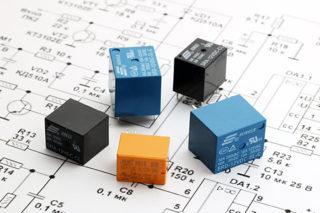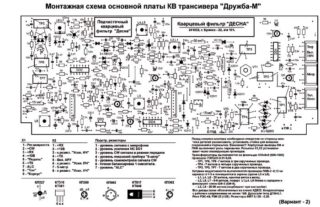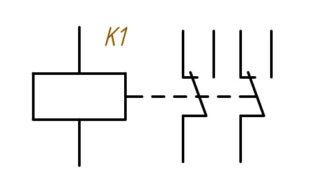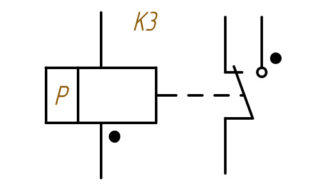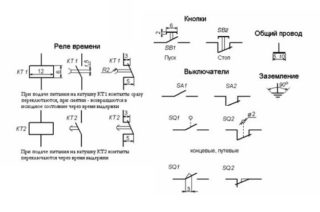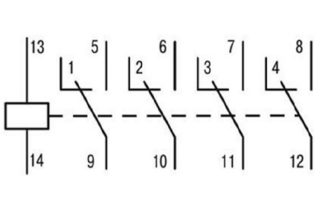For completeness of information about the product and the features of its work, electrical circuits are used. The user can not get confused during the assembly due to the introduction of alphanumeric markings in ESKD. The designation of the relay in the diagram complies with GOST 2.702-2011, which describes in detail the elements of the device and decrypts the values.
Relay Protection Marking
To indicate relay protection, markers of machines, devices, apparatuses and the relay itself are used in the drawings. All devices are depicted under voltage-free conditions in all power lines. According to the type of purpose of the relay device, three types of circuits are used.
Circuit diagrams
The basic drawing is carried out on separate lines - operating current, current, voltage, alarm. The relays on it are drawn in a disassembled form - the windings are on one part of the drawing, and the contacts are on the other. There is no marking of the internal connection, clamps, operating current sources in the circuit diagram.
Complex connections are accompanied by inscriptions indicating the functionality of individual nodes.
Wiring diagram
The marking of protection devices is carried out on working circuits intended for panel assembly, control or automation. All devices, clamps, connections or cables reflect the connection.
The wiring diagram is also called executive.
Block diagrams
Allow to highlight the general structure of relay protection. The nodes and types of mutual relations will be designated already. For marking organs and nodes, rectangles with inscriptions or special indexes are used to explain the purpose of using a particular element. The structural diagram is also supplemented by conventional signs of logical connections.
Symbol
On the electrical circuit, the relay is usually denoted by a rectangle, from the sides of which the lines of the solenoidal power leads extend.
Graphic Markers
The graphic method of depicting elements is implemented through geometric shapes:
- contacts - similar to switch contacts;
- devices with contacts near the coil - dashed line connection;
- contacts in various places - serial number next to the rectangle;
- polar relay - a rectangle with two pins and a point near the connector;
- commutation of the switch during operation - a bold point at a fixed contact;
- closed relay contacts after voltage is removed - a circle is drawn on the designation of a closed or open contact;
- magnetically controlled contacts (reed switch) in the housing - circle;
- number of windings - inclined lines;
- moving contact - arrow;
- single-line conductive surface - a straight line with branch leads;
- annular or cylindrical collector surface - a circle;
- jumpers (relay as a voltage divider) for cutting the network - a line with detachable connection symbols;
- jumper switch - U-shaped bracket.
Relay contacts can be signed.
Letter designation
The UGO relay is not enough to correctly read the circuit. In this case, the lettering method of marking is used. The relay code is the English letter K. For a clear understanding of what a letter on a relay circuit can indicate, it is worth referring to the table.
| Letters | Decryption |
| AK | Block relay / protective complex |
| Akz | Resistance Relay Kit |
| Ka | Current relay |
| Kat | R. current with BNT |
| Kaw | R. current with braking |
| Kaz | Current relay with filter functions |
| KB | R.blocking |
| Kf | R. frequency |
| Kh | Index |
| Kl | Intermediate |
| F | Fuse |
| Xn | Fixed connection |
| XT | Collapsible connection |
| Kqc | On relay |
| Kqt | Off relay |
| Kt | R. time |
| Ksg | Thermal |
| Kv | R. voltage |
| K 2.1, K 2.2, K 2.3 | Contact Groups |
| XT | Terminals |
| E | Elements to which the relay is connected |
| NO | Normally open contacts |
| NC | Normally Closed Contacts |
| COM | General (switching) contacts |
| mW | Power consumption |
| mV | Sensitivity |
| Ω | Winding resistance |
| V | Voltage rating |
| mA | Rated current |
Letters can be used on a graphic diagram.
Designations depending on relay types
Depending on the type of relay device can be indicated on the schemes in different ways.
Thermal Relay Models
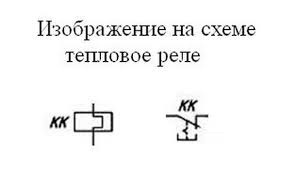 Thermal protection relays are used to ensure normal operation of consumers. Devices turn off the electric motor instantly or after some time, preventing damage to the insulating surface or individual components.
Thermal protection relays are used to ensure normal operation of consumers. Devices turn off the electric motor instantly or after some time, preventing damage to the insulating surface or individual components.
In the diagrams, the thermal relay is designated as KSG and is connected to a normally-closed contact. The connection is made according to the TP system - to the output of the low-voltage motor starter.
Time relay
The time switch is designated as KT and operates on the principle of pausing under a certain effect. The device may also have cyclic activity.
For the designation of contacts operating in accordance with GOST 2.755-87, the following are used:
- arc down - delay after applying voltage;
- arc down - contact that is triggered upon return;
- two arcs in the opposite direction - delay when applying and removing control voltage.
Pulse make contacts are designated as follows:
- a dash at the bottom with a diagonal angular line and an arrow without a lower part - pulse closure when triggered;
- dash at the bottom with a diagonal angular line and an arrow without the upper part - impulse closure when returning;
- dash at the bottom with a diagonal angular line and a normal arrow - pulse closure at the moment of operation and return.
The supply voltage supplied to the time relay is marked on the diagrams as a blue graph. The direction of voltage to the devices is indicated as a gray graph. The response delay range is indicated by red arrows. The time interval reflects the letter T.
Current relay
A current relay monitors current and voltage. An increase in the first parameter indicates a hardware or line problem.
In the diagrams, the device is marked as KA (the first letter is common for the relay, starter, contactor, the second is specifically for the current model). In the presence of BNT it will be designated KAT, braking - KAW, filtering - KAZ. The coil in the drawings is depicted as a rectangle, the size of which is 12x6 mm. Contacts are marked normally open or normally closed.
The voltage winding is marked as a rectangle divided into two parts horizontally. The letter U is indicated in the smaller one, and even lines are directed horizontally up and down.
The current winding is indicated as a rectangle divided into two sectors in the horizontal direction. In the larger horizontal above and below there are two dashes. The letter I with the larger icon (maximum current) is written on the smaller one.
Features of the designation of electromagnetic relays in the diagrams
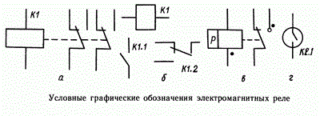 Structurally, an electromagnetic relay is an electromagnet with one or more contact groups. Their symbols form the UGO device. The winding of the electromagnet is drawn as a rectangle with output lines on both sides. Contact markers K are located opposite the narrow side of the winding and are connected by a dashed line (mechanical connection).
Structurally, an electromagnetic relay is an electromagnet with one or more contact groups. Their symbols form the UGO device. The winding of the electromagnet is drawn as a rectangle with output lines on both sides. Contact markers K are located opposite the narrow side of the winding and are connected by a dashed line (mechanical connection).
The contact output can be depicted on the one hand, and the contacts are near the UGO switching. The binding of contacts to a specific relay is indicated in the form of serial numbering (K 1.1., K 1.2).
Inside the rectangle, parameters or design features may be indicated. For example, in the symbol K 4 there are two inclined lines, i.e. the relay has two windings.
Modifications with magnetically controlled contacts in a sealed enclosure are marked with a circle to distinguish them from standard devices. This is the symbol of a reed switch. The affiliation of an element to a specific device is prescribed in the form of contact letters (K) and ordinal numbers (5.1, 5.2).
The reed switch, controlled by a permanent magnet and not included in the design of relay protection, has the coding of the automatic switch - SF.
Intermediate relay
Intermediate relay devices are used for switching electrical circuits. They amplify an electric signal, distribute electric energy, interfacing radio engineering elements. The symbol of the coil is a rectangle with the letter K and the serial number in the drawing.
The designation of the contacts of the intermediate relay on the circuit is carried out using a letter, but with two digits that are separated by a dot. The first indicates the serial number of the relay device, the second indicates the number of the contact group of this device. The contacts located near the coil are connected by hatching.
Marking of wiring diagrams and conclusions is made by the manufacturer. It is applied to the lid that covers the working bodies. Contact parameters are registered under the circuit - maximum switching current. Some brands number conclusions from the connection side.
In the diagrams, the contacts are depicted in a state without supplying voltage.
Types and symbols of relay contacts
Depending on the design of the relay, there are three types of contacts:
- Normally Open. Open before current is supplied through the relay coil. The letter designation is HP or NO.
- Normally closed. They are in a closed position until the current flows through the relay coil. Indicated by the letters NC or NC.
- Flip / switch / general. They are a combination of normally open or normally closed contacts. Equipped with a common switching drive. Literal symbols - COM.
To date, relays with cross over contacts are common.
A thorough study of the features of marking is not necessary. Alphanumeric characters can be written out or printed out and then used for assembly. If geometric shapes seem complicated, you can always refer to the lettering.
